Tokyo
16 Analysis by 罗叶(LUO YE)
罗叶(LUO YE)
How shinto is incorporated in Japanese anime
Japanese culture has always been very interesting. The food, society, history and entertainment. However, during recent years people have been more interested in japanese culture and society, since anime has been gaining popularity. It has gained so much popularity that people of other nations go to Japan and try to learn the culture and language. People are amazed how Japanese culture and society are almost similarly portrayed in anime; mostly their way of life. The lifestyle of a Japanese person is very interesting because their way of life is mixed in with their religion Shinto. The anime movie “Spirited away” by Hayao Miyazaki portrays many symbols of shinto in their movie. This film demonstrated many japanese values that japanese follow to have a better life.

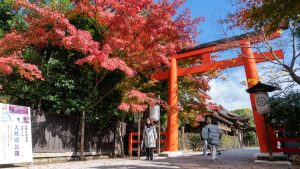
What is Shinto
Before talking about how shinto is embedded in japanese society and how the anime movie Spirited away represents that. A quick introduction of shinto is needed to really understand the concepts of the movie. Shinto which translates to “way of the gods” is an ancient japanese religion. it does not have a founder nor a time period which the religion started. The goal of Shinto is to ensure harmony between humans and the kami. Shinto is polytheistic religion however, one thing that is interesting in shinto religion is that when a person dies the spirit of the person that passed away becomes like a god. In return the Japanese people respect the dead because they have reached that level in their afterlife. Shinto religion is a very unique religion because the Japanese people practice their own religion without even knowing. It is part of their way of life. Additionally Shinto does have many rituals as any other religion. One ritual is the shrine’s etiquette. In Edward Yagisawa’s article it illustrates and teaches the person on how to enter a shrine the respectful way: the shrine etiquette. Yagisawa states, “ Before entering the torii gates bow slightly, and when entering walk on the side of the path to the shrine rather than in the middle. The middle of the path and the torii are for the gods, not for humans. On the way to the shrine, you will see a small pavilion with a basin filled with water; this is called the chozuya and this is where you purify yourself before approaching the main shrine. Fill the ladle with water and pour some water on your left hand, then right hand. Next, clean your mouth by holding the ladle in your right hand again and pouring some water into your left hand and rinse lightly – don’t wash your mouth directly from the ladle! Finally, hold the ladle vertically, allowing for the remaining water to trickle down the handle and clean it. When you reach the shrine you are now finally ready to pay your respects. It is a bit of a long ritual but the steps are Bow slightly ,Gently toss a coin into the box in front of you. The amount of money does not matter; just because you used a 500 yen coin, it does not mean that there is a higher chance of your wishes coming true. Many Japanese people believe that using a 5-yen coin increases their chances of finding a significant other, since go-en is homophonous to the Japanese word meaning “relationship.” However, this is nothing more than an urban legend; gods existed before the yen currency did ,Ring the bell if there is one 2 or 3 times to signal to the gods that you have arrived ,Deeply bow twice until you reach a 90 degree angle ,Clap twice, with your left hand slightly in front ,Pay your respects, remembering to thank the gods as well ,Deeply bow once.” (Yagisawa) This ritual is very important to japanese people mostly the water cleansing because in the shinto religion water purifies people from their impurities and sins.
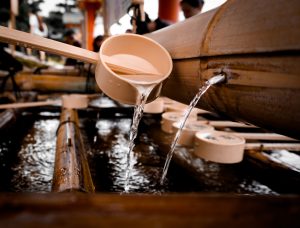
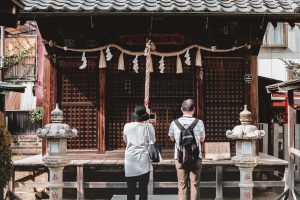
Spirited away and shinto
In the movie, the shinto religion is integrated within the movie. Spirited Away is about a 10 year old Japanese girl named Chihiro, who, with her parents, are moving to a new town. The parents took a wrong turn and ended up in a dead end and a building was in front of them. The parents decided to investigate what was in the old building. Chihiro did not want to go in because she felt something was wrong. In this scene, Chihiro follows the shinto rules that she instinctively values and follows. She knows that what her parents are doing is wrong. however she was scared of being left alone so she decided to go anyway. As they proceeded to enter the building they saw an old train lobby which astonished them. However as they went further in they and went through the other exit they saw an abandoned theme park. They were curious and went out to investigate more; however , it was at that moment that their lives would change. When the parents went deeper into the abandoned theme park they saw some food and started eating it without permission. However, Chihiro did not because she had a bad feeling about it. As they continued eating they got fatter and fatter. Then when the nightfall came they turned into pigs. Then as she got scared she ran as she was running when she saw a bath house and she ran to it when she did the ground filled with water, then she saw a train that stopped in front of the bath house. When the doors opened she saw how many yokai and gods were getting out of the train and she was afraid and went to hide. In this specific scene when the ground starts to fill up with water it is a sign of purifying as i mentioned before. Since the ground is dirty the kami cannot touch the ground hence the ground fills up with water when the train comes in to drop off the kami. A boy named Haku helped her by getting her to calm down and help her on how she can turn her parents back to normal which was hard. So Haku told her to get a job at the bathhouse so she can be protected. There she starts her journey to find a way to turn her parents back to normal. Furthermore, in the movie Chihiro was assigned to the big blob monster that was coming in the bath house. Nobody wanted to attend him therefore chihiro was forced to attend. As the big blob monster came in he left a big pile of mud and other nasty things on the floor. People were disgusted because it smelled and looked bad. When the Big blob monster went in the bath he polluted the whole water and nobody wanted to add clean water so chihiro had to do it by herself. As she struggles to add more clean water people were expecting for her failure. However as she activated the clean water people were surprised. Then she was assigned to wash the blob monster back and as she did she found something that was stuck in him and she tied a rope around it and started pulling as people saw that they were motivated to pull with her. As they pulled thousands of unclean came out of him and was cleansed of all the nastiness. To the people surprised it was a water dragon spirit which he was very powerful and rich and rewarded chihiro with something very important that she would use later on. This scene is one of the symbols of shinto because as I mentioned before water is a purifying element that purifies uncleanliness and sins. also in the shinto religion they believed that people are positive and clean people and are born without sin and only things impure or sinful can damage the person. And to get rid of the impurity and sinfulness is to be cleansed with water and to ask other people for help to be cleansed. When the water ritual is over the person is cleansed and sin free. This scene has a lot of symbolism of the shinto religion. It also adds to how some people in Japanese society will treat you when you ask for help. Some people will ignore you and other people will think that person is unworthy and nasty. However it also shows how some people will help you in your darkest situation and those people are rewarded at the end.
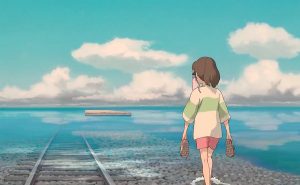
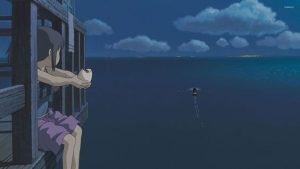
How shinto is incorporated in Japanese anime
Shinto is incorporated in Japanese culture because the whole base of the shinto religion is how to treat others and nature. If one is unbalanced there will be chaos in their belief . Anime, manga, and video games often focus on Shinto in Japanese popular culture. Pop culture in modern Japan is greatly influenced by Shinto religion, the core of Japanese culture and history. This has made Japan very famous and has done a lot of business over the last few decades. Since then, Japanese culture has spread all over the world. Without anime, Japanese culture would not be very famous as it is today. Now why do Japanese people incorporate shinto into their art and entertainment? One reason is obvious enough: it’s a part of Japanese society that how they live, it’s their way of life. However in other cultures like Korean culture they have their dramas but really do not incorporate their religion into their entertainment. So, why do Japanese input and create entertainment with the religion of shinto in the background? The answer in a way is obvious but at the same time is not. One theory is because the Japanese entertainment industry is trying to paint a picture to the rest of the world “how they really live” meaning they are trying to make an illusion to attract more people to japan and capitalize from it. The Japanese entertainment industry tries to create this fictitious but at the same time realism to viewers. An example will be Spirited away. It mixes realism with fantasy. In the first few senses you can see the realism of the anime. How Chihiro and her parents are moving into a new place and get lost on their way to the new place. After they take a wrong turn in the street there are abandoned shinto shrines. It is common in japan to see shrines all over the place and sometimes abandoned. The second theory is similar to the first theory, which is that the Japanese artist and entertainment industry are trying to paint a picture not to the outside world but to the people of japan. Why because Japan is known to be a closed off country and is also known to be a consertative country within the people mostly older generations. So the Japanese artists and entertainers are trying in a way to convince the people of Japan to open up more to have more emotion in their everyday life. To have some excitement and not only live as a robot every day.
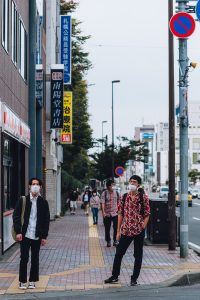

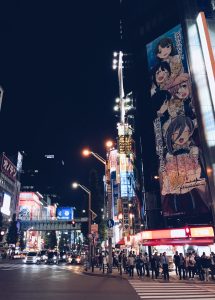
Boyd, James W. and Nishimura, Tetsuya (2004) “Shinto Perspectives in Miyazaki’s Anime Film “SpiritedAway”,” Journal of Religion & Film: Vol. 8 : Iss. 3 , Article 4.
Cartwright, Mark. “Shinto.” World History Encyclopedia, Https://Www.worldhistory.org#Organization, 3 Dec. 2022, www.worldhistory.org/Shinto/.
Hammer, Elizabeth. “Shinto.” Asia Society, asiasociety.org/education/shinto.
Kosasih, Vanessa. “Japanese Anime Culture – Tokyotreat Blog.” TokyoTreat, 4 Mar. 2019, tokyotreat.com/blog/japanese-anime-culture.
“Learn.” Japan Travel Planning, www.japan-guide.com/planning/learn.html.
“Religions – Shinto: Harae – Purification Rites.” BBC, BBC, 16 Sept. 2009, www.bbc.co.uk/religion/religions/shinto/ritesrituals/harae.shtml.
Yagisawa, Edward. “Etiquette at Shrines and Temples: A Step-by-Step Guide.” JapanTravel, 2015, en.japantravel.com/guide/shrine-temple-etiquette/20924.
Media Attributions
- kentaro-toma-psv8sI0z2GE-unsplash © Kentaro Toma
- steven-chua-Agij3FSs_88-unsplash © Steven Chua
- gio-almonte-Qnf_JasnPoM-unsplash © Gio Almonte
- kentaro-toma-9a8Q0FlbmY0-unsplash © Kentaro Toma
- spirited-away-train-tracks © Joseph Luster
- Spirited Away © Wall paper Access
- kentaro-toma-AMewVk-qEGE-unsplash © Kentaro Toma
- kentaro-toma-CjRfNwuG604-unsplash © Kentaro Toma
- gwen-king-3OdajQGd9sk-unsplash © Gwen King

